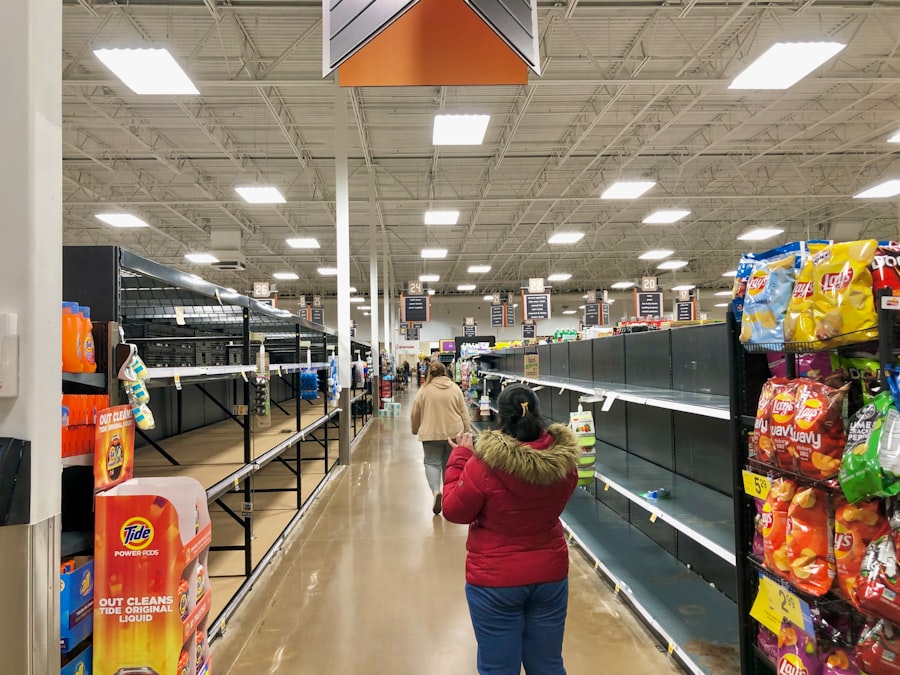Retail Link is a powerful online platform designed primarily for suppliers and vendors who partner with large retail chains, particularly Walmart.
By providing real-time insights into various aspects of retail operations, Retail Link empowers suppliers to make informed decisions that can enhance their business strategies.
The platform is not just a repository of data; it is an interactive environment that fosters collaboration between retailers and their suppliers, ultimately aiming to optimize the supply chain. The significance of Retail Link extends beyond mere data access. It plays a crucial role in the relationship between retailers and suppliers by facilitating transparency and communication.
Suppliers can monitor their product performance, track sales trends, and analyze customer behavior, all of which are essential for tailoring their offerings to meet market demands. In essence, Retail Link acts as a bridge that connects suppliers with the retail ecosystem, enabling them to respond swiftly to changes in consumer preferences and market dynamics.
Key Takeaways
- Retail Link is a web-based tool provided by Walmart to help suppliers manage their business with the retail giant.
- Access Retail Link by requesting login credentials from Walmart and logging in through the official website.
- The Retail Link dashboard provides an overview of key metrics such as sales, inventory, and forecasts.
- Different reports and tools in Retail Link help suppliers analyze sales, inventory, and performance data to make informed decisions.
- Retail Link can be used for inventory management by monitoring stock levels, identifying trends, and optimizing replenishment strategies.
How to access Retail Link
Accessing Retail Link requires a few straightforward steps, primarily aimed at ensuring that only authorized users can enter the system. First and foremost, individuals must have a valid account set up through their respective companies. This typically involves obtaining login credentials from the retailer they are partnering with, such as Walmart.
Once the account is established, users can navigate to the Retail Link website and enter their credentials to gain access. After logging in, users are greeted with a user-friendly interface that guides them through various functionalities available on the platform. It is essential for users to familiarize themselves with the login process and ensure that they keep their credentials secure.
Additionally, companies may have specific protocols in place for account management, including password updates and security questions, which users should adhere to in order to maintain uninterrupted access to Retail Link.
Navigating the Retail Link dashboard

Upon entering Retail Link, users encounter a dashboard that serves as the command center for their activities on the platform. The layout is designed to be intuitive, allowing users to quickly locate the information they need. The dashboard typically features various widgets and menus that provide shortcuts to key reports, tools, and resources.
Users can customize their dashboard according to their preferences, enabling them to prioritize the data that is most relevant to their operations. Navigating through the dashboard involves understanding the different sections and how they interconnect. For instance, users can access sales reports, inventory levels, and promotional performance metrics from the main menu.
Each section is equipped with filters and sorting options that allow users to drill down into specific data sets. This level of customization not only enhances user experience but also ensures that suppliers can efficiently manage their time while extracting valuable insights from the platform.
Understanding the different reports and tools available
| Report/Tool | Description |
|---|---|
| Google Analytics | Provides detailed insights into website traffic, user behavior, and conversions. |
| Facebook Insights | Offers data on audience demographics, post reach, and engagement on Facebook pages. |
| SEO Tools (e.g., SEMrush, Moz) | Helps analyze website performance, keyword rankings, and backlink profiles for SEO optimization. |
| Email Marketing Platforms (e.g., Mailchimp, Constant Contact) | Provides metrics on email open rates, click-through rates, and subscriber behavior. |
Retail Link offers a plethora of reports and analytical tools designed to provide suppliers with comprehensive insights into their business performance. Among the most commonly used reports are sales performance reports, which detail how products are performing across various stores and regions. These reports can be segmented by time periods, allowing suppliers to identify trends and make data-driven decisions regarding inventory and marketing strategies.
In addition to sales reports, Retail Link provides tools for inventory management, including stock levels and turnover rates. Suppliers can monitor their inventory in real-time, ensuring they maintain optimal stock levels to meet consumer demand without overstocking.
This multifaceted approach to reporting equips suppliers with the necessary information to refine their strategies continually.
Using Retail Link for inventory management
Effective inventory management is crucial for suppliers aiming to maximize profitability while minimizing waste. Retail Link plays a pivotal role in this aspect by offering real-time visibility into stock levels across various locations. Suppliers can track how much inventory is available at any given time, which helps them make informed decisions about restocking and distribution.
This capability is particularly beneficial during peak shopping seasons when demand can fluctuate significantly. Moreover, Retail Link allows suppliers to analyze inventory turnover rates, providing insights into how quickly products are selling. By understanding which items are moving quickly and which are lagging, suppliers can adjust their inventory strategies accordingly.
This proactive approach not only helps in maintaining optimal stock levels but also reduces the risk of stockouts or excess inventory, ultimately leading to improved customer satisfaction and increased sales.
Leveraging Retail Link for sales and forecasting

Sales forecasting is another critical function that Retail Link supports effectively. By analyzing historical sales data and current market trends, suppliers can make educated predictions about future sales performance. The platform’s robust analytical tools enable users to identify patterns in consumer behavior, seasonal fluctuations, and other factors that influence sales.
This information is invaluable for planning production schedules, managing inventory levels, and developing marketing strategies. Additionally, Retail Link facilitates collaboration between suppliers and retailers by providing shared access to sales forecasts. This transparency allows both parties to align their strategies more effectively, ensuring that supply meets demand without unnecessary delays or excesses.
By leveraging the forecasting capabilities of Retail Link, suppliers can enhance their operational efficiency and responsiveness to market changes.
Analyzing performance and trends using Retail Link
The ability to analyze performance metrics and trends is one of the standout features of Retail Link. Suppliers can access a variety of analytical tools that allow them to evaluate their performance against key performance indicators (KPIs). These KPIs may include sales growth rates, market share percentages, and customer satisfaction scores.
By regularly monitoring these metrics, suppliers can identify areas for improvement and capitalize on opportunities for growth. Furthermore, Retail Link enables users to conduct trend analysis over time. By comparing data from different periods, suppliers can discern patterns that may not be immediately apparent from isolated data points.
For instance, they might discover that certain products perform better during specific seasons or that promotional efforts yield varying results based on timing or location. This level of analysis empowers suppliers to make strategic decisions that align with consumer preferences and market dynamics.
Best practices for utilizing Retail Link effectively
To maximize the benefits of Retail Link, suppliers should adopt several best practices that enhance their experience on the platform. First and foremost, regular training sessions for team members can ensure that everyone is well-versed in using the various tools and reports available. This knowledge-sharing fosters a culture of data-driven decision-making within organizations.
Additionally, suppliers should establish a routine for reviewing key reports and metrics on Retail Link. By setting aside dedicated time each week or month for analysis, teams can stay informed about their performance and quickly identify any issues that may arise. Furthermore, collaborating with retail partners through shared insights can lead to more effective strategies that benefit both parties in the long run.
Troubleshooting common issues with Retail Link
Despite its user-friendly design, users may encounter common issues while navigating Retail Link. One frequent challenge is login difficulties due to forgotten passwords or account lockouts. In such cases, it is essential for users to follow the password recovery process outlined on the login page or contact their company’s IT support for assistance.
Another common issue involves discrepancies in data reporting or delays in updates. Users should be aware that data may not always reflect real-time changes due to processing times or system maintenance. In these instances, it is advisable for users to consult the help resources available within Retail Link or reach out to customer support for clarification on specific reports or metrics.
Integrating Retail Link with other supply chain management systems
Integrating Retail Link with other supply chain management systems can significantly enhance operational efficiency for suppliers. By connecting Retail Link with inventory management software or enterprise resource planning (ERP) systems, suppliers can streamline their processes and ensure consistency across platforms. This integration allows for automated data sharing between systems, reducing manual entry errors and saving valuable time.
Moreover, such integration enables suppliers to create a more holistic view of their operations by combining insights from multiple sources. For instance, linking sales data from Retail Link with production schedules from an ERP system can help suppliers optimize their manufacturing processes based on real-time demand signals. This interconnected approach not only improves accuracy but also enhances responsiveness to market changes.
Future developments and updates for Retail Link
As technology continues to evolve, so too does Retail Link. Future developments may include enhanced analytical capabilities powered by artificial intelligence (AI) and machine learning algorithms. These advancements could provide even deeper insights into consumer behavior and market trends, allowing suppliers to make more accurate predictions about future sales.
Additionally, updates may focus on improving user experience through enhanced interface design or mobile accessibility features. As more users rely on mobile devices for business operations, ensuring that Retail Link is accessible on various platforms will be crucial for maintaining its relevance in an increasingly digital landscape. Overall, ongoing improvements will likely aim at making Retail Link an even more indispensable tool for suppliers navigating the complexities of modern retail environments.
Retail Link is a powerful tool used by suppliers to manage their inventory and sales data at Walmart. For those looking to understand more about the intricacies of retail management and how platforms like Retail Link can enhance business operations, a related article can be found at this link. This resource provides valuable insights into effective retail strategies and the importance of data analytics in the retail sector.
WATCH THIS! How Walmart KILLED The American Town
FAQs
What is Retail Link Walmart?
Retail Link Walmart is an online platform that allows suppliers to access detailed information about their products’ performance in Walmart stores. It provides data on sales, inventory, and other key metrics to help suppliers make informed business decisions.
How does Retail Link Walmart work?
Suppliers can log in to Retail Link Walmart to view real-time data on their products, including sales trends, inventory levels, and promotional activity. This information can be used to track performance, identify opportunities for growth, and optimize inventory levels.
What kind of information can suppliers access on Retail Link Walmart?
Suppliers can access a wide range of data on Retail Link Walmart, including sales performance, inventory levels, promotional activity, and store-level details. This information can help suppliers understand how their products are performing in Walmart stores and make strategic business decisions.
How can suppliers benefit from using Retail Link Walmart?
By using Retail Link Walmart, suppliers can gain valuable insights into their products’ performance in Walmart stores. This can help them identify opportunities for growth, optimize inventory levels, and make informed business decisions to drive sales and profitability.
Is Retail Link Walmart only available to Walmart suppliers?
Yes, Retail Link Walmart is a platform designed specifically for Walmart suppliers. It provides suppliers with access to detailed information about their products’ performance in Walmart stores, helping them to better understand and optimize their business with Walmart.
